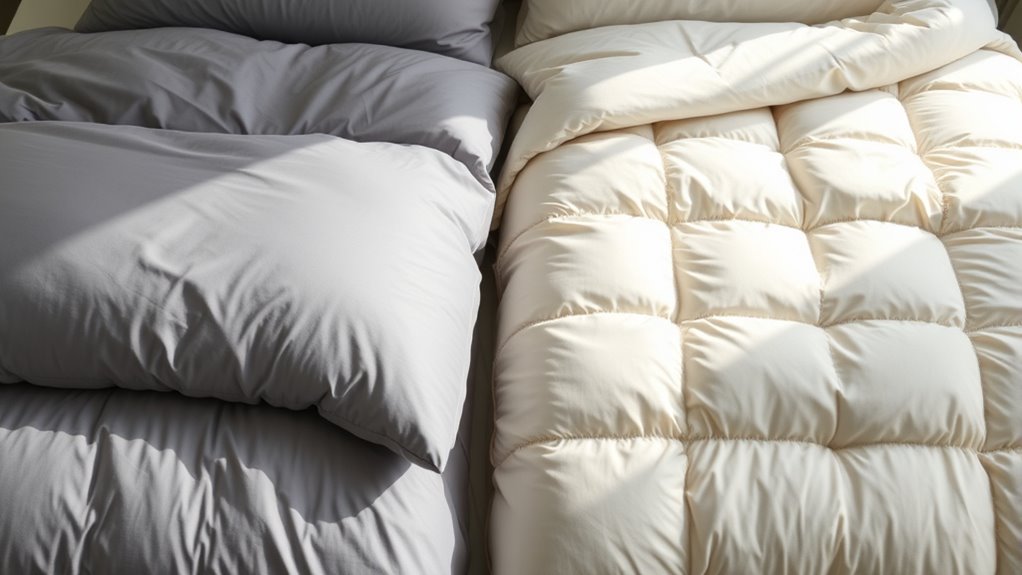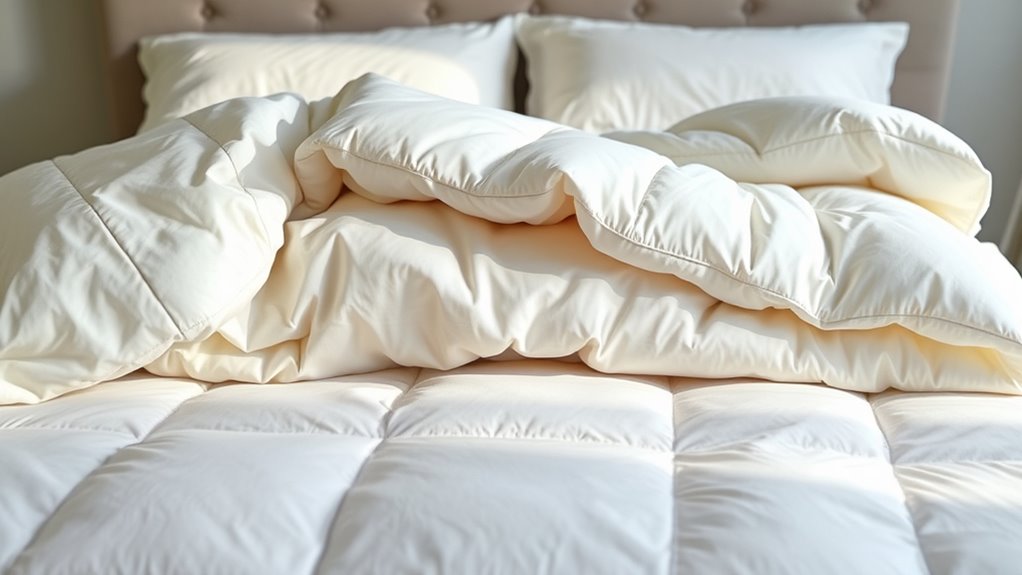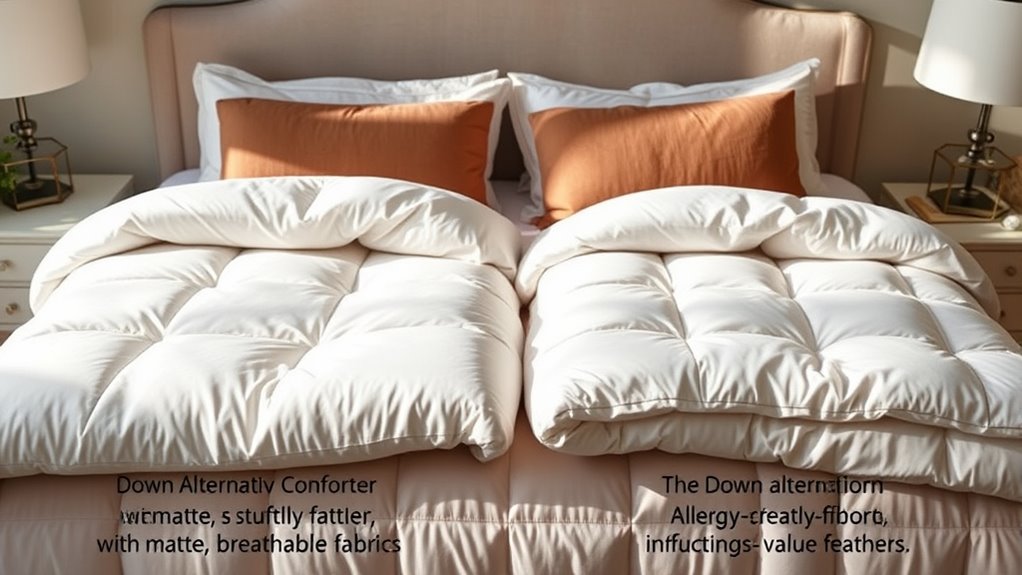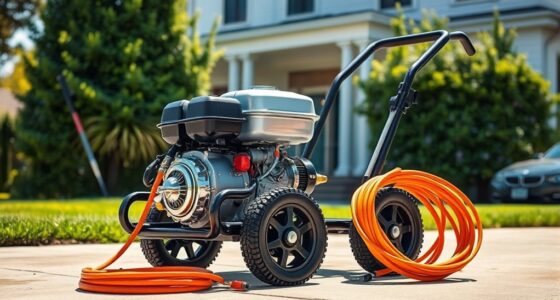If you’re sensitive to allergens, a down alternative comforter might be the best fit because it’s made from hypoallergenic, easy-to-clean materials that resist dust mites and mold. Down comforters offer superior warmth and breathability but require more maintenance and can trigger allergies. Both options can be suitable, depending on your needs, budget, and lifestyle. To discover which choice suits you best and how to maximize comfort, keep exploring the differences further.
Key Takeaways
- Down alternatives are hypoallergenic, resisting dust mites and mold, making them more suitable for allergy-sensitive sleepers.
- Down comforters, made from natural feathers, may trap allergens unless treated or kept hypoallergenic.
- Down alternatives are easier to clean and maintain, reducing allergen buildup over time.
- Natural down offers superior warmth and breathability but requires careful cleaning to prevent allergy triggers.
- Both options can be allergy-friendly; choose hypoallergenic down or synthetic fills for optimal allergy prevention.
Understanding Down Comforters and Their Allergy Risks

While down comforters are known for their softness and insulation, they can pose allergy risks if not properly maintained. These comforters, made from natural materials like duck or goose feathers, may trap dust mites and mold, increasing allergen exposure. Regular cleaning with specialized detergents helps remove dirt, dust, and potential allergens, reducing allergy risks. Choosing hypoallergenic down comforters with responsible sourcing minimizes the chance of triggering reactions. Additionally, utilizing air filtration systems can help improve indoor air quality and reduce airborne allergens that may settle in bedding. Proper storage and airing practices are essential, as dust mite buildup can occur if the comforter is not regularly aired out. However, if not properly cleaned and stored, dust mites can build up, exacerbating allergy symptoms. Using breathable covers and airing your down comforter frequently can further reduce allergen buildup. Employing natural filtration systems and selecting eco-friendly materials can significantly improve water quality and overall safety for allergy sufferers. Understanding the importance of maintenance and source transparency helps you select and care for down comforters that are both cozy and allergy-friendly.
Benefits of Down Alternatives for Sensitive Sleepers

If you’re sensitive to allergens, down alternatives offer significant benefits. They’re made from hypoallergenic materials that resist dust mites, mold, and mildew, making them safer for your sleep environment. Plus, they’re easy to clean and maintain, reducing the buildup of allergens over time. Additionally, many down alternative products feature air purification technology, which can further improve indoor air quality and support healthier sleep conditions. Using hypoallergenic fabrics can also help minimize allergic reactions and create a more comfortable sleep environment for sensitive individuals. Incorporating features like temperature regulation can also help maintain a comfortable sleeping environment for sensitive individuals, especially when paired with digital air purifiers that enhance overall air quality in your bedroom. Advances in AI-driven air quality monitoring are increasingly enabling smarter adjustments to optimize sleep comfort.
Hypoallergenic Material Benefits
For sensitive sleepers, down alternative comforters provide notable hypoallergenic benefits that promote healthier sleep environments. Made from synthetic fibers like polyester or natural fibers such as cotton, they are inherently resistant to dust mites and mold. Unlike traditional down, these comforters are resistant to allergens, making them an allergy-friendly choice. They help prevent allergen buildup, reducing triggers for asthma and allergy symptoms. Many options are cruelty-free, offering an animal-free alternative that aligns with ethical values. Because they are machine washable, you can easily clean your comforter to remove dust, dirt, and allergens, maintaining a cleaner sleep space. Additionally, choosing hypoallergenic materials can further enhance allergy protection. The use of antimicrobial treatments on some down alternatives can also inhibit the growth of bacteria and mold, contributing to a healthier sleeping environment. Incorporating breathable fabrics can improve airflow and moisture regulation, further supporting allergy prevention. Moreover, selecting comforters with certified quality standards can provide added assurance of safety and efficacy. When selecting a down alternative, considering environmentally friendly options can also benefit eco-conscious consumers. Overall, the hypoallergenic qualities of down alternatives make them a safer, more comfortable choice for sensitive sleepers seeking a healthier night’s rest.
Ease of Cleaning
Down alternative comforters are particularly appealing for allergy-sensitive sleepers because of their ease of maintenance. You can machine wash them at home, making regular cleaning straightforward. Unlike natural down, they don’t require dry cleaning, which minimizes your exposure to irritants during maintenance. Proper care involves running a gentle cleaning cycle to remove dust, pollen, and skin particles that can trigger allergies. This regular washing helps keep your bedding free from irritants and mold buildup. Down comforters often need delicate dry cleaning or special wash cycles, increasing the risk of allergen exposure if not properly maintained. With down alternatives, you enjoy consistent hygiene and peace of mind, knowing your comforter is easy to clean and helps support a healthier, allergy-friendly sleep environment. Additionally, air purifier maintenance may be necessary for air purifiers used in your sleeping area to maintain optimal air quality. Regular washing of bedding materials also reduces dust mites and allergens that can accumulate over time, especially since allergen control strategies are crucial for sensitive sleepers. Maintaining the cleanliness of your bedding with hypoallergenic materials further enhances allergy protection and promotes better sleep.
Reduced Allergen Exposure
Since sensitive sleepers are prone to allergies triggered by dust mites and mold, choosing a hypoallergenic comforter can make a significant difference. Down alternative comforters with synthetic fillings resist common allergens like dust and mold, helping you reduce allergen exposure. These hypoallergenic options are often treated to prevent dust mite accumulation, lowering the risk of allergy flare-ups. While properly washed comforters can reduce allergens, they still pose a higher risk compared to synthetic-filled, allergy-sensitive bedding. For those with sensitivities, down alternative comforters offer a safer, more comfortable sleep environment by minimizing exposure to elements that trigger allergies. Additionally, allergenic materials are designed to prevent the growth of mold and dust mites, further enhancing allergy protection. Using hypoallergenic bedding can significantly decrease allergen buildup in your sleep environment, leading to fewer symptoms and more restful nights.
Material Composition and What Sets Them Apart

The key differences between down and down alternative comforters lie in their filling materials and fabric construction. Down uses natural feathers for warmth and loft, while alternatives rely on synthetic or natural fibers to mimic that softness. These variations influence not only comfort but also durability and care requirements. Additionally, for those with allergies, down alternative options typically offer a more allergy-friendly sleep environment. Modern manufacturing techniques also allow down alternative comforters to be crafted with hypoallergenic fabrics, further reducing allergy concerns. Furthermore, down alternative comforters can be designed with easy-care features, making maintenance simpler for allergy sufferers.
Filling Materials Differences
Filling materials are the key difference between down and down alternative comforters, shaping their warmth, weight, and maintenance. Down comforters are filled with natural clusters of feathers from ducks or geese, offering lightweight, breathable insulation. In contrast, down alternative comforters use synthetic fibers like polyester microfiber or natural materials such as cotton or wool, designed to mimic down’s plush feel.
Imagine:
- Soft, airy down clusters providing natural loft
- Dense, resilient synthetic fibers mimicking insulation
- Fill power measuring fluffiness and warmth
- Natural materials offering breathability and easy care
- Synthetic fibers creating heavier, less breathable layers
Material composition impacts comfort, warmth, and maintenance, making each suitable for different needs and sensitivities.
Fabric and Construction
Fabric and construction differences substantially influence the feel, durability, and maintenance of down and down alternative comforters. Down comforters typically feature high-thread-count cotton fabric, with baffle box stitching that prevents feather migration and maintains even fill distribution. This construction helps the loft stay consistent and prevents compresses over time. In contrast, down alternative comforters use synthetic fibers or natural materials like cotton and silk, designed to mimic the plushness of real down. Their construction often includes fiber clusters and a loft that enhances fluffiness, while being hypoallergenic and easier to care for. These materials are resilient, machine washable, and dry quickly. The choice of fabric and construction impacts not only comfort but also longevity, making it an essential consideration when selecting an allergy-friendly comforter.
Comparing Insulation, Breathability, and Warmth

When comparing insulation, breathability, and warmth, it’s clear that down comforters often outperform their synthetic counterparts. Natural down’s high fill power (550-750) creates superior loft, trapping air efficiently for excellent insulation. This results in a lightweight, fluffy feel that adapts to your body’s movements. Imagine:
Natural down offers superior loft, insulation, and breathability for cozy, comfortable sleep.
- Soft natural down clusters that trap warmth like tiny air pockets
- Moisture wicking that keeps you dry and comfortable
- Better temperature regulation, preventing overheating or chills
- Loft that maintains warmth even if conditions get damp
- Breathability that allows heat and moisture to escape, ideal for hot sleepers
Synthetic down, needing denser filling, often falls short in breathability and warmth. Natural down’s superior insulation and moisture wicking make it a top choice for cozy, breathable comfort.
Maintenance, Durability, and Longevity Factors

Maintaining the longevity of your comforter depends heavily on how you care for it. Proper maintenance and handling directly influence durability and lifespan. Down comforters can last 10-15 years with proper care, but they require delicate cleaning—often professional dry cleaning—to prevent damage. In contrast, down alternatives are washable and dryable at home, making maintenance easier and reducing risk of wear. Down comforters are more sensitive to moisture and compression, which can diminish their resistance and shorten their lifespan if not stored or fluffed regularly. Proper care, like fluffing and storing in breathable bags, helps preserve loft and insulation. Overall, down alternatives tend to have a shorter lifespan but are easier to maintain, while down comforters demand careful handling to maximize their durability.
Cost Differences and Value Considerations

Choosing between down and down alternative comforters often comes down to cost and long-term value. Down comforters tend to have a higher price, ranging from $200 to over $1,000, but they’re a long-term investment, lasting 15-20 years. In contrast, down alternatives are more budget-friendly, costing $50 to $300, and are easier to maintain with machine washing. Imagine:
- A luxurious, durable comforter that maintains its softness for years
- An affordable option fitting within your budget constraints
- A comforter that requires professional cleaning, adding to costs
- A lightweight, hypoallergenic choice for sensitive sleepers
- A long-lasting investment that balances price and durability
Ultimately, your choice depends on weighing the initial cost against the value of longevity and lower maintenance expenses.
Choosing the Right Comforter for Your Allergies and Preferences

Selecting the right comforter depends considerably on your allergies and personal preferences. If you’re allergy-sensitive, opt for a hypoallergenic synthetic or down alternative comforter, as these resist dust mites and mold better than traditional down. Synthetic comforters are allergy-friendly and easier to care for—they can be machine washed and properly cleaned to reduce allergen buildup. Down comforters, while luxurious, may harbor allergens if not regularly professionally cleaned, increasing allergic reactions. For breathability and comfort, look for comforters designed with breathable fabrics to regulate temperature and moisture. Maintenance is key—regular washing and proper care help keep allergy symptoms at bay. Ultimately, choosing a synthetic or hypoallergenic down alternative ensures a cleaner, more comfortable, and allergy-friendly sleep environment tailored to your needs.
Frequently Asked Questions
Are All Down Alternative Comforters Hypoallergenic?
You wonder if all down alternative comforters are hypoallergenic. Not necessarily—while most are made from synthetic fibers like polyester that resist dust mites and mold, some may not be inherently hypoallergenic. To guarantee allergy-friendliness, always check product labels and certifications. Regular washing helps remove allergens, but choosing comforters specifically labeled hypoallergenic gives you extra assurance. So, read carefully and select those designed for allergy sufferers.
Is Down Comforter Bad for Allergies?
You might wonder if a down comforter worsens your allergies. While natural down isn’t inherently allergenic, unwashed or untreated down can trap dust, mold, and allergens, potentially triggering reactions. However, if you choose a well-cleaned, hypoallergenic down comforter with allergen-proof covers, it can be suitable for allergy sufferers. Regular cleaning and maintenance are key to keeping down comforters allergy-friendly and comfortable for your sleep.
Which Is Better, Down Alternative or Down Comforter?
Have you ever woken up sneezing from your comforter? When choosing between down alternative and down, it depends on what matters most to you. If allergies and easy maintenance top your list, a down alternative is your best bet—hypoallergenic and machine washable. But if you want long-lasting, natural insulation and don’t mind extra care, a down comforter offers superior loft and breathability. Consider your priorities and choose accordingly.
Do Hotels Use Down or Down Alternative Comforters?
You might wonder what kind of comforters hotels use. Many hotels prefer down alternative comforters because they’re hypoallergenic, easier to clean, and maintain their look over time. High-end hotels sometimes opt for natural down with allergen-proof covers for a luxurious feel. Overall, the choice depends on factors like budget, guest preferences, and cleaning needs, but comfort and practicality often guide hotels toward down alternatives.
Conclusion
Ultimately, choosing between down and down alternative comforters comes down to your allergies and comfort preferences. Many believe that synthetic options are inherently less cozy, but modern materials prove otherwise—they can be just as warm and breathable. If you prioritize allergy-friendliness, a high-quality down alternative might surprise you with its performance. So, don’t dismiss the options; explore what suits your sleep style best and enjoy restful, allergy-free nights.









